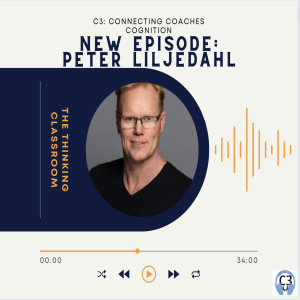
Wednesday Dec 06, 2023
Peter Liljedahl: The Thinking Classroom
-Building thinking classrooms- around the notion that students spend time in classrooms not thinking. Many structures are not designed for thinking, and instead for conformity and compliance. 15 years of research before the book, and the research continues.
-One of the least conducive places to have students do thinking is at their seat writing in their notebook, but one of the most conducive spaces for students to do thinking is standing in random groups of three, at a whiteboard or something vertical and erasable. It is about getting them up and thinking.
-Task in relation to the student. If we want our students to think we have to give them something to think about. To be a thinking task it needs a particular relationship to the student.
-The whiteboard is a better space for that thinking to manifest. Everyone has to be able to access the task.
-Whiteboard- Everyone is oriented with the work the same way, they can see other students’ progress, I can access their learning more readily, I as the teacher can intervene right now. Standing is just so much better than sitting. When students are sitting they feel anonymous. The further from the student, the more anonymity. When they feel anonymous they are more disengaged.
-More engagement from a question if written on a whiteboard, as opposed to printed on paper.
-You have five minutes. They are with you on your feet and talking to each other. Research shows beyond five minutes, the more passive students become and the transition to being an active learner is harder.
- In a thinking classroom you say the minimum possible to start question number one. Then we can give them another question and another. We can never unsay what we say at the beginning. The moment we tell them how to do it, we have sucked the thinking out of the task. Need to bring order to their thoughts.
-Mimicking: Template for exactly how to do this problem. Mimicking is not the same as thinking or learning. It is mastering or memorizing routines that they truly need to make meaning. Students take the process and plug it into the template teachers present. Mimicking always runs out. How do we break these habits? How do we help students and ourselves break these habits? We have to break the habit ourselves and then support them and give them success.
-Students don't listen to what we say, they listen to what we do. When teachers are too perfect, students try to be too perfect.
- I can’t hear what you are saying, your actions are too loud.
-Divergent vs. convergent thinking - Gallery walk. The teacher is the guide and we are taking a tour. We are going to look at little portions of the boards. Present the tentative learning with students. Others talk about the board work, we invite them to think about it and draw conjectures about what it is, and then that creates a thinking discussion about this and engages in a variety of different boards this way. Are they thinking?
- We are the educators, we are creating the experience. We are very deliberate about what that experience is.
-Random groups - creates a space where students can actually learn from each other. Random groups is the engine to make all of this work.
-How can I help teachers’ notice things?
-Try to pull from teachers something that is absolutely positive about what they already do. What is the best lesson you ever taught? How do we amplify their successes instead of the urgency of the immediate?
Connect with Peter:
Buildingthinkingclassrooms.com
Facebook: Groups→ Search “Building Thinking Classrooms” and find your group 50+
No comments yet. Be the first to say something!